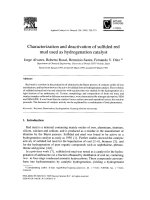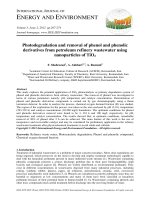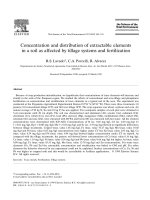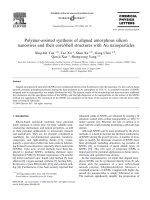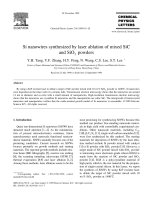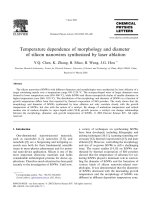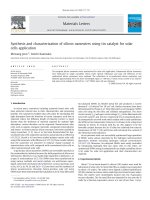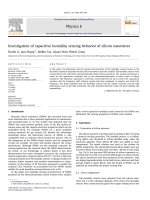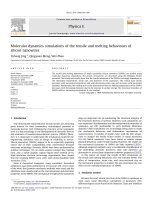- Trang chủ >>
- Khoa Học Tự Nhiên >>
- Vật lý
composite of tio2 nanowires and nafion as humidity sensor material
Bạn đang xem bản rút gọn của tài liệu. Xem và tải ngay bản đầy đủ của tài liệu tại đây (427.62 KB, 7 trang )
Sensors and Actuators B 115 (2006) 198–204
Composite of TiO
2
nanowires and Nafion as humidity sensor material
Ren-Jang Wu
a,∗
, Yi-Lu Sun
b
, Chu-Chieh Lin
b,∗∗
, Hui-Wen Chen
c
, Murthy Chavali
c
a
Department of Applied Chemistry, Providence University, 200 Chungchi Road, Shalu, Taichung, Hsien 433, Taiwan, ROC
b
Department of Chemistry, National Chung-Hsing University, Taichung 402, Taiwan, ROC
c
Center for Measurement Standards, Industrial Technology Research Institute, Hsinchu 300, Taiwan, ROC
Received 21 January 2005; received in revised form 6 September 2005; accepted 6 September 2005
Available online 10 October 2005
Abstract
Homogeneous TiO
2
nanowires were fabricated by hydrothermal method. SEM pictures proved the yield of nanowires to be more than 90%.
Composite humidity sensing films were made by using TiO
2
nanowires, TEOS and Nafion. FTIR absorption spectroscopy was used as a semi-
quantitative method to get information about the protonation. The sensing films were prepared by a dip-coating method. The composite films coated
on a pair of gold electrodes were tested for humidity sensors of resistance type. The measurement was carried out at five fixed humidity points
in the range of 12–97% relative humidity, which were controlled by employing five different salt solutions. Resistance changes were about three
orders of magnitude. The nanowires-based humidity sensors showed moderate sensitivity, short response and recovery time (<2 min) at relative
humidity less than 76%, and good long-term stability.
© 2005 Elsevier B.V. All rights reserved.
Keywords: Nanowires; Nafion; Humidity; Impedance
1. Introduction
Needs for humidity sensors are growing in industrial and
agricultural applications for monitoring and controlling the
surroundings is growing. Different measuring techniques, like
impedance [1,2], capacity [3–5], field effect transistors (FET)
[6], surface-acoustic wave (SAW) [7], quartz crystal microbal-
ance (QCM) [8–11], fiber optic [12–15] and microwave sensors
[16], have been explored for humidity detection. In recent years,
nanorod and nanowire films were fabricated and their humid-
ity sensitive characteristics have been investigated [17–19], and
these nanomaterial films were found to be efficient humid-
ity sensors. In consideration of quality and cost, impedance
type humidity sensors are becoming more prevalent. Humidity-
sensitive materials used in various fields are classified into three
groups: electrolytes, organic polymers and porous ceramics
[20].
∗
Corresponding author. Tel.:+8864 26328001x15212;fax: +886 426327554.
∗∗
Corresponding author. Tel.: +886 4 22840411x718.
E-mail addresses: (R J. Wu),
(C C. Lin).
Ceramic humidity sensorsusually show better chemical resis-
tance and mechanical strength than polymer sensors. TiO
2
sens-
ing materials are commonly used in research for the reason
of easy fabrication. Gusmano and co-workers [21,22] used the
TiO
2
modified with 1–10% K
+
and Li
+
through a sol–gel method
as a sensing material. The electrical resistance of the material
showed a variation of seven orders of magnitude with the change
in relative humidity (RH) from 4 to 90%. A humidity sensing
material ZrO
2
–TiO
2
increased the sensitivity by doping with
Li
+
in the research of Jain et al. [23]. Nitsch et al. [24] used an
active thick film layer based on ZnO–TiO
2
–Cr
2
O
3
as a sens-
ing material. Traversa and co-workers [25] used the technology
of electrochemical impedance spectroscopy to investigate the
humidity-sensing electrical conduction mechanism of the films
of TiO
2
doped with 1–10% K
+
and Li
+
in the RH range of 4–87%
RH.
TiO
2
nanowires are a kind of nano-scale material and have
been successfully synthesized by some research groups through
hydrothermal treatment, chemical vapor deposition or other
methods [26–28]. The TiO
2
nanowires are very intriguing as a
humidity-sensing material. In the present study, therefore, com-
posite films ofTiO
2
nanowires and Nafion were made,since such
composites of fine ceramic particles and polymers are often used
as humidity sensors [1,2,31].
0925-4005/$ – see front matter © 2005 Elsevier B.V. All rights reserved.
doi:10.1016/j.snb.2005.09.001
R J. Wu et al. / Sensors and Actuators B 115 (2006) 198–204 199
2. Experiment
2.1. Fabrication of TiO
2
nanowires
TiO
2
nanowires were prepared by using hydrothermal
method in our laboratory. One gram of anatase TiO
2
powder
(Sigma–Aldrich Co., Inc., USA) was placed into a Teflon-lined
autoclave, and40 ml of10 M aqueous NaOHsolution was added.
Heating was maintained at 200
◦
C for24 h without stirring. After
the autoclave was cooled to room temperature naturally, the
obtained sample was washed sequentially with a dilute aqueous
HCl solution, distilled deionized water and ethanol sequentially
several times. A fibrous white crystalline product was obtained
after drying the sample at 70
◦
C for 6 h.
2.2. Sensing material fabrication
Humidity sensing materials were fabricated by mixing the
TiO
2
material (powder or nanowires), a Nafion solution and a
tetraethyl orthosilicate (TEOS) solution by the weight ratio of
1:500:500, but at various ratios for subsequent studies, including
0% for each component. The purity of the anatase TiO
2
pow-
der was >99% (Sigma–Aldrich Co., Inc., USA). The Nafion
®
solution was obtained from Aldrich (USA) and the concen-
tration was 5 wt.% in a mixture of lower aliphatic alcohols
and water. The TEOS (98%) as a binding material was pur-
chased from ACROS Organic Co., Inc., USA and was dissolved
into a mixed solution of methanol and water at a volume ratio
of TEOS:C
2
H
5
OH:H
2
O = 5:16:2. The sensing films were dip
coated on an alumina substrate of 10 mm × 5 mm on which pair
of comb-like gold electrodes had been made (see Fig. 1), fol-
lowed by drying at 120–150
◦
C for 1 h.
2.3. Measurement systems setup
An LCZ meter (DU-6022, made from Delta United Instru-
ment Co., Ltd.) was used in measuring the impedance signals of
the humidity sensors.
The standard humidity measurement system is shown
in Fig. 2. Actually, five systems with different humidity’s
were setup. The humidity in each setup was controlled by
employing five different saturated salt solutions, and was
calibrated with a standard fixed-point calibration with a
standard hygrometer (Rotronic M-131, UK) to the humid-
Fig. 1. Structure of a humidity sensor element.
ity standard of National Measurement Laboratory, Taiwan,
ROC. The five humidity-controlling salt solutions of LiCl,
MgCl
2
, NaBr, NaCl and K
2
SO
4
were kept at a constant tem-
perature 25 ± 2
◦
C and the resulting humidity values were
12.0 ± 0.2, 33.2 ± 0.4, 50.0 ± 0.4, 75.8 ± 0.2 and 96.9 ± 0.6%
RH, respectively. Each humidity system has a dimension of
150 mm × 120 mm × 100 mm. Before first measurement of a
sensor, aging of each sensor was performed for 2 weeks in a 97%
K
2
SO
4
salt solution system. Long-term stability of the sensors
was tested in the humidity measurement systems for about 8
months.
Data on the temperature effect were obtained from experi-
ments carried out under the divided flow humidity system [8].
The divided flow humidity generator contained a dry-air flow
and a saturated humidity-air flow. The saturated humidity-air
and dry air were mixed together and then fed into a bottle-like
test chamber with a volume of 10 l to generate air of the required
humidity at a total flow rate of 10 l min
−1
.
The apparatus for the divided flow system was Protec PC-540
from Sierra Instruments Inc., which was equipped with two mass
flow controllers and flow display power-supply. The humidity
sensors prepared were tested and calibrated in the test chamber.
The relative humidity, RH, of the test chamber was approxi-
mately given by
%RH=
M
sat
M
sat
+ M
dry
f × 100%
Fig. 2. Humidity measurement system.
200 R J. Wu et al. / Sensors and Actuators B 115 (2006) 198–204
where M
sat
and M
dry
were the flow rates of saturated air and
dry air, and ‘f’ was the coefficient of this system which was
dependent on temperature and flow rate. The homemade sim-
ple apparatus has been developed for producing air of a known
relative humidity at temperatures ranging from 15 to 35
◦
C.
2.4. FTIR experimental
The composite materials of TiO
2
–TEOS–Nafion were sub-
jected to FTIR analysisusinga Horiba Fourier transform infrared
spectrometer [FT-720, Japan] equipped with a DTGS detec-
tor. A NaCl crystal of 25 mm × 4 mm size (Spectral Systems
Inc., #955-3616, USA) was used to obtain the spectra. Each
spectrum was collected at room temperature under atmospheric
pressure, at an average of 64 scans with a 2 cm
−1
resolution in
a transmission mode from 400 to 5000 cm
−1
. In all experiments
background spectra were measured.
3. Results and discussion
3.1. SEM observations of TiO
2
nanowires
SEM pictures revealed that TiO
2
nanowires were successfully
fabricated by a hydrothermal method in our laboratory. Fig. 3a
and b and other SEM pictures revealed a high yield of nanowires
Fig. 3. SEM photographs of TiO
2
nanowires: (a) magnification of ×40,000; (b)
magnification of ×10,000.
Fig. 4. Humidity characteristic curves of various TiO
2
materials: ()TiO
2
nanowires/Nafion, ()TiO
2
powder/Nafion, (᭹) Nafion, ()TiO
2
nanowires,
()TiO
2
powder.
over 90%. The average length of the wires was about 5–10 m,
and the average diameter was 40–50 nm.
3.2. Response due to addition of TiO
2
and Nafion
The original response calibration curve was defined by using
the materials of TiO
2
powder and nanowires combined with
TEOS in Fig. 4. Impedance (Z/Ω) was the parameter of the
humidity measurement. A good sensitive characteristic curve
was not observed with the sensing materials of TiO
2
powder and
nanowires combined with TEOS in the humidity ranging from
10 to75%. The figure also reveals that mixingthe inorganic TiO
2
and organic hydrophilic Nafion changes the sensing curve. The
addition of Nafion was found to result in a remarkable increase
in sensitivity and a decrease in the impedance of the humidity
sensor. Nafion has been reported to enhance the water adsorption
at the sites of hydrophilic ionic group, –SO
3
H
−/+
[29].
The composite of TiO
2
nanowires/Nafion exhibited the
higher sensitivity 2–3-folds than those of the composite TiO
2
powder/Nafion or Nafion film alone. The impedance change
from the humidity range of 12–97% was more than three orders
of magnitude. Especially in the humidity range of 10–40%, the
TiO
2
nanowires/Nafion revealed a better sensitivity curve. Some
nanomaterials like carbon nanotubes (CNTs) had been used in
our laboratory process to promote the adsorption of water [30].It
has been reported that the SiO
2
/Nafion composite can add to the
stability and good linearity of the sensor [31]. A SEM picture of
the composite TiO
2
nanowires/Nafion sensing film is shown in
Fig. 5. Most of the TiO
2
nanowires kept their original shape. A
part of nanowires penetrated into the surface of Nafion and some
remained on the surface. Nanowires have unusual electrical,
optical, magnetic, mechanical, thermal and biological proper-
ties due to their dimensions and high aspect ratios [length to
width ratio]. Thus TiO
2
nanowires with homogeneous morphol-
ogy and high specific surface area can adsorb moisture easily and
R J. Wu et al. / Sensors and Actuators B 115 (2006) 198–204 201
Fig. 5. SEM photograph of TiO
2
nanowires/Nafion.
uniformly. The high sensitivity of the TiO
2
nanowires/Nafion is
therefore attributed to theenhanced water adsorption on theTiO
2
nanowires.
3.3. FTIR experimental data
A typical infrared (IR) spectrum of the composite material
was recorded on a NaCl crystal. Several bands were identified
from the obtained FTIR spectrum typical to the components
of the composite material (see Fig. 6). Most of the obtained
vibrational bands were similar to those of the published data.
TiO
2
-anatase formnanowires having characteristic peaks at638,
513 and 397 cm
−1
were observed in the FTIR spectrum. The
peak at 397 cm
−1
is not completely evident in the spectrum due
to the usage of NaCl crystal that has a cutoff nearly equal to
400 cm
−1
. Nevertheless, an initiation of the prominent peak,
that is specifically characteristic to TiO
2
-anatase, is obviously
visible from 404 cm
−1
.
A broad peak between 800 and 465 cm
−1
is assigned to the
Ti–O–Ti stretching vibrations [13–15] with a valley centered
at 517 cm
−1
. The peak at 638 cm
−1
is superimposed with that
of a strong IR absorption peak of Si (640 cm
−1
) from TEOS
in the combined composite material spectrum. The peaks at
800 and 969 cm
−1
are due to Si–O–Si and Si–OH, respectively,
also from TEOS. In addition there were also less significant
IR peaks at 509, 611, 755 and 805 cm
−1
and a prominent
peak at 669 cm
−1
. The band Ti–OH observed below 3500 cm
−1
indicates the existence of hydrogen bonding. This interaction
between the organic and inorganic phase is favorable for the
improvement of the thermal stability and optical transparency
of the composite films. The IR spectrum of the hydrated titanium
dioxide [h-TiO
2
] shows a large broad band between 3250 and
3490 cm
−1
and narrow bands at 1641 and 1454 cm
−1
. The broad
band at 3250–3490 cm
−1
is assigned to the stretching mode of
hydroxyl, δ
OH
, while those at 1641 and 1454 cm
−1
are assigned
to bending modes of hydroxyl δ
OH
, respectively [32–34]. Com-
pared with the intensity of the characteristic absorption bands
of Ti–OH below 3500 cm
−1
, an increase in peak area ratio sug-
gests increase in humidity sensing is due to the anatase TiO
2
nanowires.
Humidity sensing of Nafion is usually observed at 1300 and
1056 cm
−1
, which are anti-symmetric stretching and symmet-
ric stretching vibrations of the –SO
3
−
, respectively. However,
the anti-symmetric stretching vibrations of the–SO
3
are unfortu-
nately shrouded by the strong C–F stretching bands exactly over
1300 cm
−1
. Nevertheless humidity sensing can be evidenced
with the transfer of proton and the shift in peak centered at
1057 cm
−1
. The presence of –SO
3
−
also accounts indirectly
for the proton transfer, supported by the increase in relative
peak area ratio at 1300 cm
−1
, thus resulting in the disappear-
ance of asymmetric bands of the SO
3
H
−
group at 1410 and
910 cm
−1
and the changes in relative peak area ratios at 1057
and 1300 cm
−1
.
Fig. 6. FTIR spectrum of a TiO
2
[anatase] nanowires–TEOS–Nafion composite.
202 R J. Wu et al. / Sensors and Actuators B 115 (2006) 198–204
Fig. 7. Humidity response curve of TiO
2
nanowires/Nafion.
3.4. Response signal and hysteresis
A response curve of the TiO
2
nanowires/Nafion film is shown
in Fig. 7. The response and recovery time T
90
(T
90
is defined as
the time requiredto reach the 90% of the final equilibrium signal)
was less than 1.5 min at the humidity range, of 12–75%. The
response time at thehumidity of97%was much longer than those
for the humidity ranging from 12 to 76%. This phenomenon was
also observed with the Nafion film.
Fig. 8 reveals the hysteresis data of the TiO
2
nanowires/
Nafion film. Hysteresis was calculated as: [log
10
(impedance
descending) log
10
(impedance ascending)/log
10
(impedance
descending at fixed point RH)]. The hysteresis of the sensing
film was small (calculated <2%).
3.5. Temperature effect and long time stability test
Temperature has some interference on the resistance sig-
nal of the TiO
2
nanowires/Nafion film as shown in Fig. 9.
R
= R
0
exp(−E
a
/RT) was used to calculate the activation energy
(E
a
) of water adsorption on the sensing film. R
represents the
Fig. 8. Hysteresis effect of TiO
2
nanowires/Nafion film: () descending humid-
ity, () ascending humidity.
Fig. 9. Temperature effect of TiO
2
nanowires/Nafion film: ()35
◦
C, ()25
◦
C,
()17
◦
C.
Fig. 10. Long time stability test of TiO
2
nanowires/Nafion film: () 12% RH,
(᭹) 33% RH, () 50% RH, () 76% RH, () 97% RH.
resistance of the humidity sensor, R is the gas constant and T
the absolute temperature. E
a
of 12.9 kcal mol
−1
was calculated
from the slope of the plot of ln(R) with ln(1/T) in 60% humidity
with a temperature interval of nearly 10
◦
C.
The test data of long-term stability is shown in Fig. 10. The
impedance values of the sensor at five different testing points of
12, 33, 50, 76 and 97% RH did not show obvious deviation for
250 days.
4. Conclusion
In this research, humidity sensing was investigated by using
the TiO
2
nanowires/Nafion material. For humidity range of
12–97% the change in resistance of the TiO
2
nanowires/Nafion
sensing film was observed to be more than 1000. The nanowires
humidity sensor showed moderatesensitivity, shortresponse and
R J. Wu et al. / Sensors and Actuators B 115 (2006) 198–204 203
recovery time (<2 min) for smaller than 76% humidity and a
good long-term stability for up to 250 days.
References
[1] D.G. Yarkin, Impedance of humidity sensitive metal/porous silicon/n-Si
structures, Sens. Actuators 107 (2003) 1–6.
[2] F. Tailoka, D.J. Fray, R.V. Kumar, Application of Nafion electrolytes for
the detection of humidity in a corrosive atmosphere, Solid State Ionics
161 (2003) 267–277.
[3] L. Gu, Q A. Huang, M. Qin, A novel capacitive-type humidity sensor
using CMOS fabrication technology, Sens. Actuators B 99 (2–3) (2004)
491–498.
[4] C. Cantalini, M. Pelino, Microstructure and humidity-sensitive character-
istics of Fe
2
O
3
ceramic humidity sensor, J. Am. Ceram. Soc. 75 (1992)
546–551.
[5] W.S. Wang, A.V. Virkar, A conductimetric humidity sensor based on
proton conducting perovskite oxides, Sens. Actuators B 98 (2004) 282–
290.
[6] S.P. Lee, K.J. Park, Humidity sensitive field effect transistors, Sens.
Actuators B 35–36 (1996) 80–84.
[7] K.A. Vetelino, P.R. Story, R.D. Mileham, D.W. Galipeau, Improved dew
point measurements based on a SAW sensor, Sens. Actuators B 35–36
(1996) 91–98.
[8] M. Neshkova, R. Petrova, V. Petrov, Piezoelectric quartz crystal humidity
sensor using chemically modified nitrated polystyrene as water sorbing
coating, Anal. Chim. Acta 332 (1996) 93–103.
[9] F.P. Delannoy, B. Sorli, A. Boyer, Quartz crystal microbalance (QCM)
used as humidity sensor, Sens. Actuators B 84 (2000) 285–291.
[10] L.X. Sun, T. Okada, Simultaneous determination of the concentration
of methanol and relative humidity based on a single Nafion(Ag)-coated
quartz crystal microbalance, Anal. Chim. Acta 421 (2000) 83–92.
[11] S. Mintova, T. Bein, Nanosized zeolite films for vapor-sensing applica-
tions, Micropor. Mesopor. Mater. 50 (2001) 159–166.
[12] P. Kronenberg, P.K. Rastogi, P. Giaccari, H.G. Limberger, Relative
humidity sensor with optical fiber Bragg gratings, Opt. Lett. 27 (2002)
1385.
[13] L. Xu, J.C. Fanguy, K. Soni, S. Tao, Optical fiber humidity sensor based
on evanescent-wave scattering, Opt. Lett. 29 (2004) 1191–1193.
[14] W. Kunzler, S.G. Calvert, M. Laylor, Measuring humidity and moisture
with fiber optic sensors, in: E. Udd, S.T. Kreger, J. Bush (Eds.), Pro-
ceedings of the SPIE, vol. 5278, Sixth Pacific Northwest Fiber Optic
Sensor Workshop, November 2003, pp. 86–93.
[15] T.L. Yeo, T. Sun, K.T.V. Grattan, D. Parry, R. Lade, B.D. Powell, Char-
acterisation of a polymer-coated fibre Bragg grating sensor for relative
humidity sensing, Sens. Actuators B 110 (2005) 148–156.
[16] C. Bernou, D. Rebiere, J. Pistre, Microwave sensors: a new sensing prin-
ciple. Application to humidity detection, Sens. Actuators B 68 (2000)
88–93.
[17] Y.S. Zhang, K. Yu, D.S. Jiang, Z.Q. Zhu, H.R. Geng, L Q. Luo, Zinc
oxide nanorod and nanowire for humidity sensor, Appl. Surf. Sci. 242
(2005) 212–217.
[18] Q. Wan, Q.H. Li, Y.J. Chen, T.H. Wang, X.L. He, X.G. Gao, J.P.
Li, Positive temperature coefficient of resistance and humidity sens-
ing properties of Cd-doped ZnO nanowires, Appl. Phys. Lett. 84 (2004)
3085–3087.
[19] R J. Wu, Y L. Sun, H W. Chen, Promoting effect of TiO
2
nanowire
composited with Nafion material application in measurement of humid-
ity, Chem. Sens. 20 (Suppl. B) (2004) 372–373.
[20] N. Yamazoe, Y. Shimizu, Humidity sensors: principles and applications,
Sens. Actuators B 10 (1986) 379–398.
[21] G. Montesperelli, A. Pumo, E. Traversa, G. Gusmano, A. Bearzotti,
A. Montenero, G. Gnappi, Sol–gel processed TiO
2
-based thin films as
innovative humidity sensors, Sens. Actuators B 24–25 (1995) 705–709.
[22] E. Traversa, G. Gnappi, A. Montenero, G. Gusmano, Ceramic thin films
by sol–gel processing as novel materials for integrated humidity sensors,
Sens. Actuators B 31 (1996) 59–70.
[23] M.K. Jain, M.C. Bhatnagar, G.L. Sharma, Effect of Li
+
doping on
ZrO
2
–TiO
2
humidity sensor, Sens. Actuators B 55 (1999) 180–185.
[24] K. Nitsch, B.W. Licznerski, H. Teterycz, L.J. Golonka, K. Wisniewski,
AC equivalent circuits of thick film humidity sensors, Vacuum 50 (1998)
131–137.
[25] G. Gusmano, A. Bianco, G. Montesperelli, E. Traversa, An EIS study of
the humidity-sensitive electrical conduction of alkali-doped TiO
2
films,
Electrochim. Acta 41 (1996) 1359–1368.
[26] X.Y. Zhang, G.H. Li, Y.X. Jin, Y. Zhang, L.D. Zhang, Hydrothermal
synthesis and photoluminescence of TiO
2
nanowires, Chem. Phys. Lett.
365 (2002) 300–304.
[27] S.K. Pradhan, P.J. Reucroft, E. Yang, A. Dozier, Growth of TiO
2
nanorods by metalorganic chemical vapor deposition, J. Cryst. Growth
256 (2003) 83–88.
[28] T. Kasuga, M. Hiramatsu, A. Hoson, T. Sekino, K. Niihara, Titania
nanotubes prepared by chemical processing, Adv. Mater. 11 (1999)
1307–1311.
[29] C D. Feng, S L. Sun, H. Wang, C.U. Segre, J.R. Stetter, Humidity
sensing properties of nation and sol–gel derived SiO
2
/Nafion composite
thin films, Sens. Actuators B 40 (2–3) (1997) 217–222.
[30] H W. Chen, R J. Wu, K.H. Chan, Y L. Sun, P.G. Su, The application
of CNT/Nafion composite material humidity sensing measurement, Sens.
Actuators B 104 (2005) 80–84.
[31] P.G. Su, I.C. Chen, R J. Wu, Use of poly(2-acrylamido-2-methylpropane
sulfonate) modified with tetraethyl orthosilicate as sensing material
for measurement of humidity, Anal. Chim. Acta 449 (2001) 103–
109.
[32] Q. Hu, E. Marand, In situ formation of nanosized TiO
2
domains within
poly(amide-imide) by a sol–gel process, Polymer 40 (1999) 4833–4843.
[33] L.H. Lee, W.C. Chen, High-refractive-index thin films prepared from
trialkoxysilane-capped poly(methyl methacrylate)-titania, Mater. Chem.
Mater. 13 (2001) 1137–1142.
[34] W.C. Chen, S.J. Lee, L.H. Lee, J.L. Lin, Synthesis and characteriza-
tion of trialkoxysilane-capped poly(methyl methacrylate)-titania hybrid
optical thin films, J. Mater. Chem. 9 (1999) 2999.
Biographies
Ren-Jang Wu is an assistant professor in Department of Applied Chemistry
at Providence University. He received a BS in Chemistry from National Tsing
Hua University in 1986, an MS in Chemistry from National Taiwan University
in 1988 and a PhD in Chemistry from National Tsing Hua University in 1995.
His main areas of interest are chemical sensors, catalysis, nanoscience and
chemical standard technology.
Yi-Lu Sun received a BS degree in Chemistry from Soochow University in
1995, and an MS degree in Chemistry from National Chung-Hsing University
in 1997. He entered the PhD course of Chemistry at National Chung-Hsing
University in 2003. His main areas of interest are inorganic chemistry and
chemical sensor technology.
Chu-Chieh Lin is a professor of Department of Chemistry at National
Chung-Hsing University. He received a BS degree in Chemistry from Soo-
chow University in 1981, an MS degree in Nuclear Science from National
Tsing-Hua University in 1983 and a PhD degree in Chemistry from Texas
Tech University in 1992. His research interests are in inorganic chemistry
and chemical sensor technology.
Hui-Wen Chen received a BS in Chemistry from Chung Yuan Christian
University in 1998, and an MS in Chemistry from National Chung-Hsing
University in 2000. Her main areas of interest are electroanalytical chemistry
and chemical sensor technology.
Murthy Chavali received MSc (Tech.) in Chemistry from Jawaharlal Nehru
Technological University, India in 1994 and PhD Tech in 2000 from Technis-
che Universit
¨
at Wien, Austria in Analytical Chemistry. He was a postdoctoral
204 R J. Wu et al. / Sensors and Actuators B 115 (2006) 198–204
scientist at Center for Instrumental Analysis, Kobe University, Japan, on
Japanese National Fellowship (JSPS) worked for NIR combustion sensors.
He served as Researcher at NSC-Taiwan for a short period. After that he
joined as a Researcher with sensors and standards group at CMS/ITRI-
Taiwan. His research interests are optical waveguide technology, IR sensors,
LIF, chip based chemical and biochemical sensors ( & n), development
and application of spectroscopic techniques for the study of nanomaterials.
His present work focuses on synthesis and fabrication of various organic and
inorganic nanostructures, nanocomposite materials, broadly nanotechnology
applications for gas and liquid sensors.
